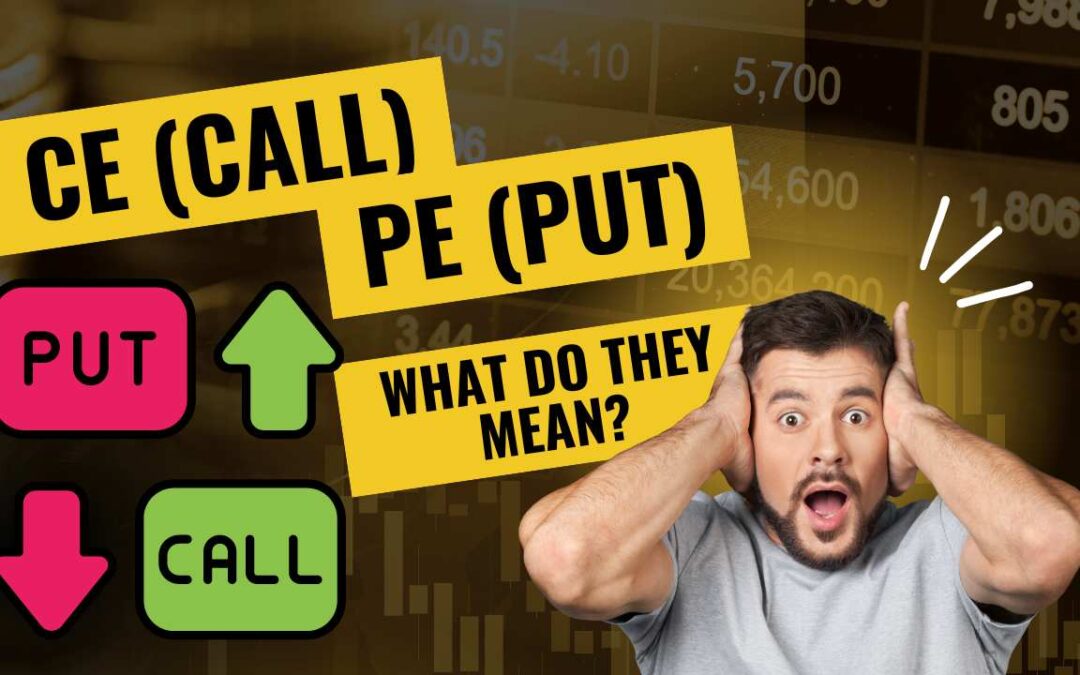If you are a beginner and looking to know What Is Ce And Pe In Stock Market, you’ve come to the right place.
I’ll brief you about everything related to Options in this blog post with 16 years of stock market experience.
MUST READ: The Basics of Stock Market for Beginners Book
So What Is CE And PE in Stock Market?
- CE stands for Call Option and is abbreviated to Call European as it was picked from Britishers.
- PE stands for Put Option. They are like contracts but without any obligation. and is abbreviated to Put European as it was picked from the European stock market.
- With CE, you have the choice to buy something like stocks. You don’t have to, but you can. It’s your call.
- PE lets you sell if you want to. But again, you don’t have to.
- Folks should buy a CE or sell a PE when they think prices will rise.
- If they figure out the prices will fall, they will go for buying a PE or selling a CE.
- CE and PE are important in the Indian stock market. They help manage risks, speculate, and create plans.
- It’ll help to know how CE and PE work below and its relative terms below, especially if you want to make the most of the market ups and downs.
MUST READ: The Basics of Stock Market for Beginners Book
Primary Factors Influencing Option Prices:
Figuring out how a Call Option (CE) or Put Option (PE) will increase its price based on its underlying assets in the Indian stock market involves various factors and is not a measure we can have.
But Let’s examine the crucial considerations that influence CE and PE price rise or fall:
1) Underlying Asset’s Price Shift:
- This is the main factor impacting CE and PE value.
- If the stock (or index) price goes in the direction that helps the option (up for CE, down for PE), the option’s value usually goes up.
- The size of this uptick depends on how much the price moves.
2) Volatility:
- How much the underlying asset’s price swings around is called volatility.
- More swings often lead to higher option premiums.
- So, if swings increase, CE and PE values might go up if everything else stays the same.
- On the flip side, if swings decrease, the option value might go down.
3) Time Decay:
In options trading, there’s this term called: “time decay” or “theta decay.”
It simply means an option’s worth slowly decreases as its expiration date nears.
Picture it this way; options are like perishable goods, they don’t last forever.
Each passing day reduces their worth slightly.
If you consider a piece of fruit, it starts to rot with time. Every new day makes it a bit less fresh, less appealing.
Similarly, time lessens the likelihood that the option will yield profits, thus its value declines.
- Options have a finite life meaning every option dies on the day of expiry.
- Their value goes down as they get closer to the end of life meaning expiry day.
- This decrease speed up as the end of life gets closer.
- This behavior is called time decay or theta decay.
- So, if all else stays the same, an option’s value goes down over time.
- But, if the underlying asset moves helpfully, this can counter some of the time decay.
4) Strike Price and Intrinsic Value:
Strike Price Definition and Explanation:
When you trade options, the strike price is set ahead of time by the exchange.
This price level is where you can buy or sell the core asset if you choose to use your option. The strike price is where you, the option holder, have the right to purchase (for a call option) or sell (for a put option) the asset.
An option may have several strike prices at once.
These prices usually stretch above and below the asset’s current market price.
The count of strike prices can change as per the movement of underlying assets.
This is influenced by things like how volatile the asset is and the option’s expiry date.
Intrinsic value Definition and Explanation:
See, there’s something called intrinsic value. It’s like the real value of an option, figured out from the current market price of whatever asset you are considering.
With call options, the intrinsic value is whatever positive difference there is between the asset’s price right now and the strike price, that’s if the asset is priced higher.
For put options, it’s different. Intrinsic value here is the positive difference between the strike price and the current asset price, but only if the asset’s price is on the low side.
No intrinsic value? That means the option is “out of the money.”
Sounds fancy, but really, it’s just about the minimum value of an option.
It’s a key factor for figuring out whether an option has the potential to be profitable or not.
- I wish to give the jargon more easily, but you got to know the terms without which you’ll suffer trading options.
- The gap between the option’s strike price and the current price of the underlying asset gives the option’s intrinsic value.
- If the strike price is good compared to the current asset price,
- In-the-money options have positive intrinsic value.
- Out-of-the-money options don’t have intrinsic value.
- The intrinsic value impacts how much the price of the option changes when the underlying asset price changes.
FAQs about Options and Options Trading in Stock Markets:
Explain Options Trading Like I’m 5 Years Old.
- Just think of options trading as a game with toy cars.
- You get to decide whether to purchase or let go of a promise to exchange a toy car at a specific cost later in time.
- If the toy appreciates in value, your pockets could grow bigger meaning you will profit.
- However, if it doesn’t, you may find yourself at a loss.
- It’s pretty much like betting with toy cars!
Is Options Trading Like Gambling?
- Trading in options carries some risk and speculation, somewhat like gambling.
- But, it’s not mere luck like you put a coin in a slot machine and turn the wheel.
- Traders use definitive strategies and thorough analysis to raise the probability of success.
- Though both options trading and gambling are sprinkled with uncertainty, traders rely on detailed studies and smart tactics in their decision-making process.
- It’s not just about odds, they consistently strive for profits.
- There is a saying “If you are 1% more sure than 50% winning, you are not Gambling”
- So simply saying options trading is definitely not gambling.
MUST READ: The Basics of Stock Market for Beginners Book
What are the similarities and differences between options trading vs futures trading?
Let’s first talk about similarities in options trading vs futures trading.
- Options trading and futures trading both involve agreements to buy or sell assets at a predetermined price in the future.
- They both offer potential for profit through speculation and hedging against price fluctuations.
- However, they differ in terms of obligations, as options provide the right but not the obligation to buy or sell, whereas futures contracts entail an obligation to buy or sell.
Let’s now look at the differences between options trading vs futures trading.
- With options trading, you get a choice to buy or sell assets for a set price – but you don’t have to. You can choose to do so before a certain date.
- Futures trading, on the other hand, locks you in. You must buy or sell things at a set price and date.
- Options have more flexibility wrt. trading but has a risk of going to a value of ZERO, but futures are more fixed and have assurance it’ll not go to NIL value and you can roll over futures to next month’s futures.
- However, this assurance comes with a catch – it’s riskier because you have obligations and involve more money with futures trading.
- For buying options, you can use a very small account of 10K, but futures trading involves a bigger pocket more than 1 Lakh in your trading account.
What are the Implications of options trading and taxes incurred in India?
In India, options trading is about buying and selling contracts that permit you to buy or sell stocks/indices at fixed strike price costs.
The taxes for options trading rely on things like how long you’ve held them and how much profit you’ve gained. Short-term profits (kept for under a year) get taxed at the regular income rates.
Long-term profits (kept for more than a year) get a tinier tax or maybe even none! Since options have an expiry and cannot be held for more than a year, short-term gains taxes imply on options trading.
Your tax fees might differ because everyone’s situation is unique and tax slabs are different. That’s why it’s a good idea to chat with a tax
expert.
MUST READ: The Basics of Stock Market for Beginners Book
How To Do Option Trading in India?
I’ve written in detail about this in my book “The Basics of Stock Market for Beginners“ including 2 strategies for trading.
However, here are the steps to understand how to do option trading in India.
Learn and Grasp the Basics Well: Grasp ideas such as call and put options, as well as things like strike prices, expiry dates, and option premiums.
Open a Trading Account: Pick a trustworthy broker firm and set up a trading account with the lowest brokerage.
Research: Study the market movement, the performance of companies, and news that impacts underlying assets.
Pick a Strategy: Based on your risk acceptance and view of the market, choose a trading strategy. Remember, once you grip, test and finalize a strategy, you gotta stick to it with discipline, no matter what.
Place Orders at the time when Stocks/ Index moves Fast: With your trading platform, put in requests to buy or sell option contracts. Because if the underlying asset moves slowly, the options will lose value due to time decay.
Keep an Eye on Positions: Monitor your positions and market shifts to make wise choices.
Manage Risks: In my book I’ve written a full chapter about Risk Management. Check out the book here. Use risk management practices like stop-loss orders to keep possible losses low.
PS: Stop loss should cut the losses, not add to the losses!
Stay Aware: Keep up with market news and constantly enhance your knowledge of option trading strategies.
What Is Option Selling in Stock Market?
- Have you heard of option selling? It’s a way people earn in the stock market.
- In simple terms, an investor can sell an “option” to another trader. This option gives the buyer the chance to either buy or sell a certain asset at a pre-decided price of strike price.
- This needs to happen within a certain time frame before expiry. The seller gets paid upfront for this.
- If the option ends up being worthless because the asset’s price doesn’t go the right way, the seller still earns a profit.
- But if the buyer uses the option and the price doesn’t favor the seller, they could end up losing all the money invested.
- Selling options can be an efficient earning money technique or protecting against price jumps also called as hedging.
- Like any trade, it has risks. The biggest one is the chance for limitless loss with naked options.
- To trade these options writing well, you need to really know your way around the market and how to manage risk.
- Ohh.. BTW, I have a full chapter dedicated to Risk Management in my book.
How To Select Stock For Option Trading?
- The best way how to select a stock for option trading is it should not have wide swings!
- Volatility should be relatively higher, as more the volatility is higher the options rise or decrease in value.
- The stocks you pick should have definitive levels of support and resistance. This will help you pick the strike prices which you can trade options.
- Last but not least the stock should follow technical analysis.
How Option Selling Works?
- Think of it like a market. You have sellers and buyers.
- The sellers have something to sell, which can be options contracts in stock markets.
- They offer these to the buyers. When this happens, the sellers get some cash right away. This cash is known as the premium.
- What are these contracts? They’re a promise. Buyers can choose to buy (this is a call option) or sell (a put option) a certain stock/index, an asset, at a set price and within a certain time.
- Now, if time runs out and the option hasn’t been used, or the cost of the asset didn’t go the buyer’s way, the seller keeps their upfront money. That’s their profit.
- But, if the option is exercised, then the seller has to fulfill the obligation. They have to keep their word and go through with the deal, even if it means they lose money.
- This is why option selling can be risky.
- It can give you income, but only if you manage those risks.
- If not, the losses could be unlimited.
MUST READ: The Basics of Stock Market for Beginners Book
What Is Premium In Option Trading?
Options trading has this price of options called a premium.
That’s the price the buyer gives the seller for buying the options from the seller. It’s sort of like the price tag for getting to choose if you want to buy (that’s a call option) or sell (that’s a put option) the stuff you’re trading at a certain price, at a price point you are comfortable.
Which Stock Is Best For Option Trading?
In the plethora of stocks, I cant suggest a name for your question which stock is best for option trading.
But let me give you the stocks best suited to trade its options as per my experience.
- There’s no one “top” stock for options trading.
- It changes with your trading plans, how much risk you can handle, and the market’s mood.
- What matters most? Trading Volumes, Volatility, and Price Shifts.
- Stocks with lots of trading and price swings often draw in options traders.
- Big blue chip stocks, tech firms, and companies about to share earnings or big news might be good choices.
How To Trade Nifty Options?
Simple when you wanna trade nifty options, select the strike prices around the Nifty futures output.
Keep a close eye on the delta of the options. Deep In-The-Money (ITM) options have a delta almost equal to 1 and move as per the Nifty Futures price.
Select the CE and PE of Nifty strike prices in the watchlist and trade the options you want.
How To Put Stop Loss In Option Trading?
- Set a limit in options trading for what you can afford to lose. This is your stop-loss.
- Put your stop losses on your terminal when to sell the option as it reaches this value.
- Always monitor your position and tweak your stop-loss as necessary.
- Contemplate the possible changes in the option’s price and the duration you want to hold it.
- It’s vital to handle your money with care in options trading, hence I’ve written a full chapter about risk management in my book.
What Is Index Option Trading?
- These contracts are tied to the value of a stock market index, such as the Sensex, FinNifty, or Nifty 50.
- It’s those indexes, not individual stocks, that influence the value of these options.
- With index options, you can guess the direction of the market.
- You can protect against market risk too.
- And, you don’t have to deal with individual stocks to get exposure to the entire market.
- Index options offer investors a way to handle risk and make a profit.
- They do it by moving in the market in a way that spreads out their risk.
- Index options have potential rewards and risks too like any individual stock options.
- The rewards can be similar to the ones you’d get with individual stock options, but lower risks as the index is more diversified.
MUST READ: The Basics of Stock Market for Beginners Book
How To Earn From Options Trading?
- It’s not very hard for Options trading to help you make money.
- You can buy and sell contracts for a profit. But how?
- It’s all about buying low and selling high, or vice versa.
- You can make money from price changes of the asset itself or the option premiums.
- Using strategies such as purchasing calls/puts, selling calls/puts, or applying spreads can boost your earnings.
Conclusion of What is CE And PE In Stock Market?
Having to write about CE and PE in options trading, I gave a heck lot more info in the post.
Making money with CE and PE is not at all hard, just follow a strategy and you are good to earn a great living with options trading.
Start stock market investing and pick your Next Multibagger Now. Also, you may trade with my system and strategy and comment if it really worked for you or not!
MUST READ: The Basics of Stock Market for Beginners Book
Follow me on Facebook and Youtube.
Happy Trading and Happy Money Making!




